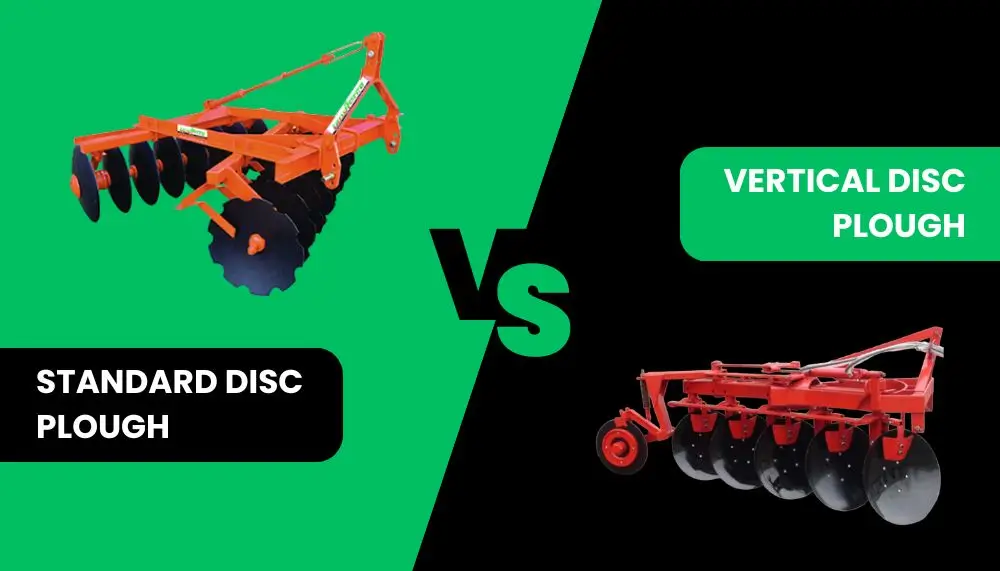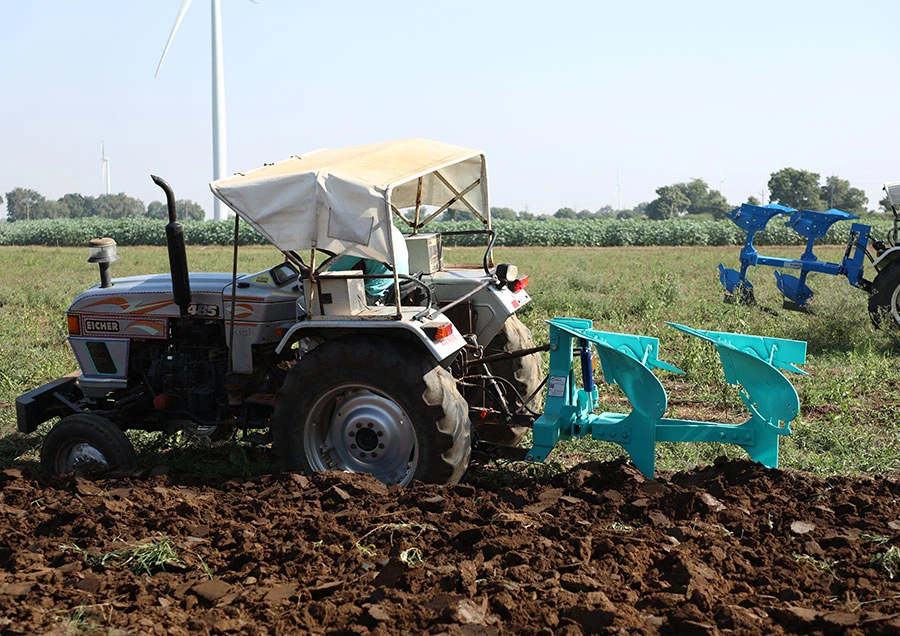Chat With Us
+91 99253 37969Standard Vs Vertical Disc Plough: How To Choose The Best?

Ploughing is an important aspect in terms of cultivation for enhanced productivity. Farmers nowadays are using disc ploughs for improved cultivation. These ploughs are procession machinery used for soil inversion. There are mainly two types of ploughs: standard disc ploughs and vertical disc ploughs.
Both types of plough serve specific purposes based on varying needs. So let’s know the difference between these two and which one is more effective. Uncover the answers through a comprehensive differentiation.
Standard Disc Plough Vs Vertical Disc Plough: Which Is Better?
Standard Disc Plough
1. Design
Standard disc ploughs have a conventional concave-shaped disc configuration. The discs possess a horizontal alignment which is connected to a common shaft. The standard designs drive power through the axial rotation of blades during the cutting and turning of the soil. The number of discs can vary between the range of 3 to 13.
2. Orientation Of Blades
In a standard hydraulic disc plough, the blades are oriented in a staggered manner. The angle created with the frame provides strength to the blades during rotation. Such an orientation of blades provides effective soil inversion by building a relatively flat angle with the soil. Moreover, the horizontal alignment of blades also helps to drive more pressure.
3. Cutting Depth and Soil Inversion
Standard disc ploughs are best for cutting the upper soil and primary tillage activities. However, they can struggle with deep penetration activities. The angular motion of blades with a horizontal shaft limits deep penetration. Therefore, standard disc ploughs are operated at a shallower depth in comparison to vertical ploughs.
4. Application
- The horizontal arrangements of discs are best suited for cutting the upper soil and inversion.
- Standard Disc Plough excels in residue management and weed control.
- Farmers use standard disc ploughs to a huge extent for soil mixing.
- Generally, used during primary tillage activities in fields with compact and heavy soil.
5. Advantages
- It provides enhanced ploughing during primary tillage activities in comparison to other ploughs.
- Effectively buries weeds and other harmful residues in the soil. Therefore, it is used for weed control.
- It is capable of churning large soil clods in seconds.
- Standard disc ploughs can be used in versatile soil conditions.
6. Limitations
- It is not operated for deep penetration and is less efficient during secondary tillage.
- Repeated operation through standard disc plough can raise the risk of soil erosion.
- Consumes more power during the tillage activity in comparison to vertical disc plough.
- Consistent implementation of standard disc plough can harm the humus layer.
Vertical Disc Plough
1. Design
Vertical disc ploughs also contain concave blades but are arranged in a V-shaped configuration. Therefore, the discs remain at a flat angle with the shaft but create an angle with the soil. Hence, the blades can dig deep into the soil which is opposite to a standard disc plough.
2. Orientation Of Blades
The orientation of blades in a vertical disc plough is just opposite to a standard disc plough. The V-shaped vertical alignment provides more power and thrust to the plough. This orientation helps to build a concavity with the soil and provides enhanced lifting and loosening of the soil.
3. Cutting Depth and Soil Inversion
Unlike standard disc ploughs, vertical hydraulic disc ploughs can penetrate deep into the soil. The vertical shaft improves the penetration power and cutting depth of the plough. The to-and-fro motion along the axis helps the discs to cut efficiently irrespective of terrain. Therefore, it provides precision soil Inversion in every condition.
4. Application
- It can be used for both primary tillage and secondary tillage activity.
- In-depth soil inversion for turning up the humus layer.
- Preparing hard and marshy soils for cultivation.
- Preventing soil erosion.
- Creating furrows for irrigation and seed beds.
5. Advantage
- Vertical disc ploughs serve enhanced soil inversion during secondary tillage activity.
- It provides higher efficiency in comparison to conventional disc ploughs.
- It can prevent soil erosion due to an innovative soil inversion technique.
- It can also be used to uproot weeds and other harmful plants from the soil.
6. Limitations
- Vertical disc ploughs can damage the upper soil on continuous application.
- High-speed cutting can not be operated due to the vertical alignment.
- It can leave the field dry and cloddy than a standard disc plough.
Summary:
| Aspects | Standard Disc Plough | Vertical Disc Plough |
| Disc Orientation | Horizontal | Vertical |
| Disc Rotation Speed | High | Moderate |
| Depth Penetration | Low efficacy | High Efficacy |
| Power Consumption | Moderate | Low |
Takeaway
In summary, both standard disc ploughs and vertical disc ploughs play a crucial role in agriculture. Proper implementation can lead to improved cultivation and higher productivity. However, the selection of the plough depends on the soil type and your requirements. Therefore, analyze the soil conditions properly for the right choice.





